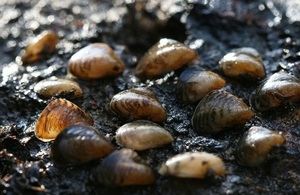Quagga mussel discovered for first time in UK
The invasive species, the quagga mussel (Dreissena rostriformis bugensis), has been discovered in the south east.

The quagga mussel is generally the size of a thumbnail but can grow to 4cm - Picture courtesy of Dr David Aldridge.
The discovery was made by Environment Agency teams carrying out routine water quality testing on River Wraysbury. It has subsequently been found in the nearby Wraysbury reservoir too.
The identification was confirmed by Dr David Aldridge of Cambridge University on 1 October 2014.
Since the mussel was identified the Environment Agency has been working with partners including Thames Water, Angling Trust and local angling clubs, to put biosecurity measures in place. Work is now taking place to monitor the River Thames and reservoirs in the local area to investigate the extent of the problem and the distance that the quagga mussel has spread.
Anglers and boaters can play an important part and everyone is urged to help stop the spread of this species by following the ‘check, clean, dry’ approach and thoroughly cleaning any equipment.
The quagga mussel is a prolific breeder – a fully mature female mussel is capable of producing up to one million eggs per year. Due to its ability to filter out large quantities of nutrients and to breed quickly, the quagga mussel can significantly reduce native populations and affect freshwater ecosystems. It can outcompete native mussels. This alters the ecology of the habitats it invades. It can also block water pipes and smother boats’ hulls.
Sarah Chare, deputy director of fisheries and biodiversity at the Environment Agency, said:
Invasive species – such as the quagga mussel – cost the UK economy in excess of £1.8 billion every year. And while Britain’s rivers are the healthiest for over 20 years, rivers that harbour non-native species could fall short of tough EU targets.
The quagga mussel is a highly invasive non-native species, affecting water quality and clogging up pipes. We are monitoring the extent of its spread and working closely with partners to ensure they are aware of it.
If you spot one then please report it to us through the online recording form. Like the zebra mussel and killer shrimp this species comes from the Ponto-Caspian region – an area around the Black and Caspian seas in south-east Europe.
Simon Earl, head of water production at Thames Water, said:
Another invasive species is the last thing we need clogging up our network. But we have a lot of experience in dealing with zebra mussels, which are similar to quagga mussels, and there is no threat to the quality of the water we supply to our customers. We’ll continue to work closely with the Environment Agency to monitor the mussels discovered at Wraysbury reservoir.
Mark Owen, head of freshwater at the Angling Trust, said:
It’s vitally important that all water users, including anglers, take every possible precaution to stop this species spreading throughout the UK. Quagga mussels could do untold damage to freshwater and estuarine environments if they are allowed to spread which could have a significant impact on marine and freshwater fish stocks.
The mussels tend to be about the size of a human thumbnail but can grow to about 4cm. The larvae of quagga mussel are not visible to the naked eye, which makes drying a critical step in applying good biosecurity. There’s good evidence that rinsing or soaking equipment in hot water increases the chance of killing larvae and adults, and is a suggested addition to the Check, Clean, Dry approach. Check, Clean, Dry is important not only to help slow the spread of this species, but also other invasive species that might be present in our waterways. It is especially important to prevent the spread of invasive non-native species to isolated, vulnerable or protected sites.
More information and advice on the quagga mussel and advice on how to slow its spread can be found on the Non-native Species Secretariat web pages: http://www.nonnativespecies.org/alerts/quaggamussel.